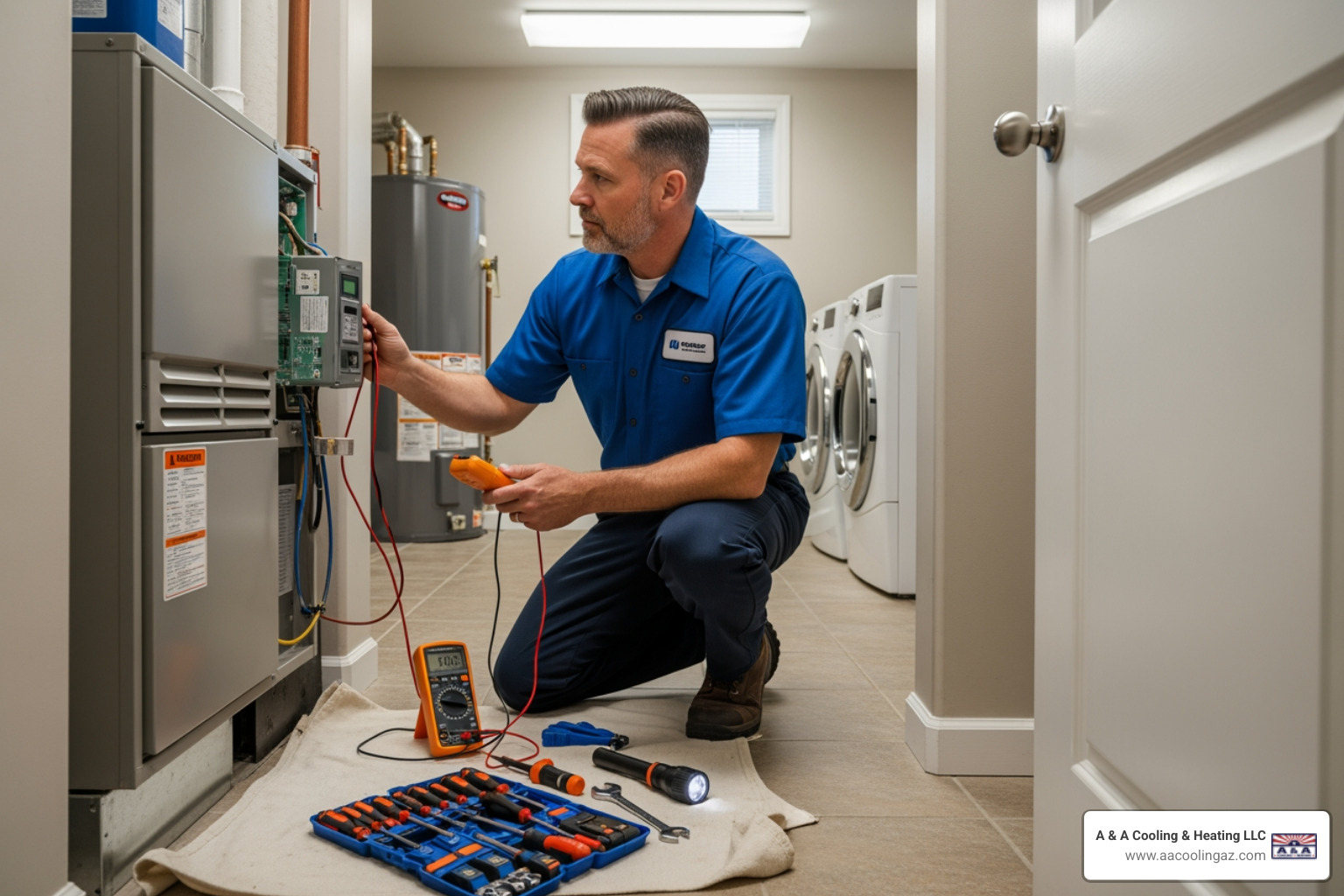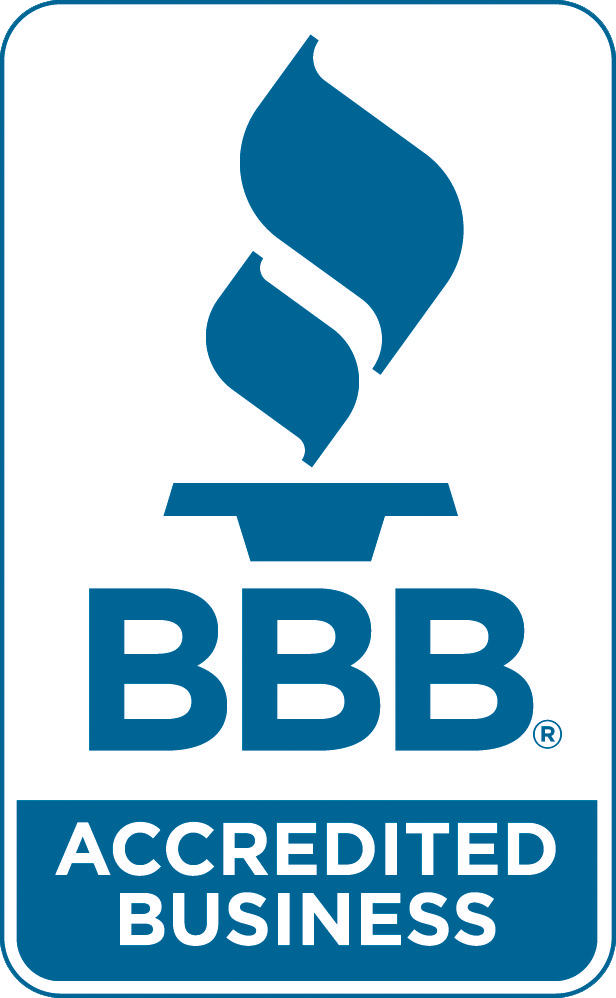Spin Your Way to Savings: AC Fan Motor Repair Guide
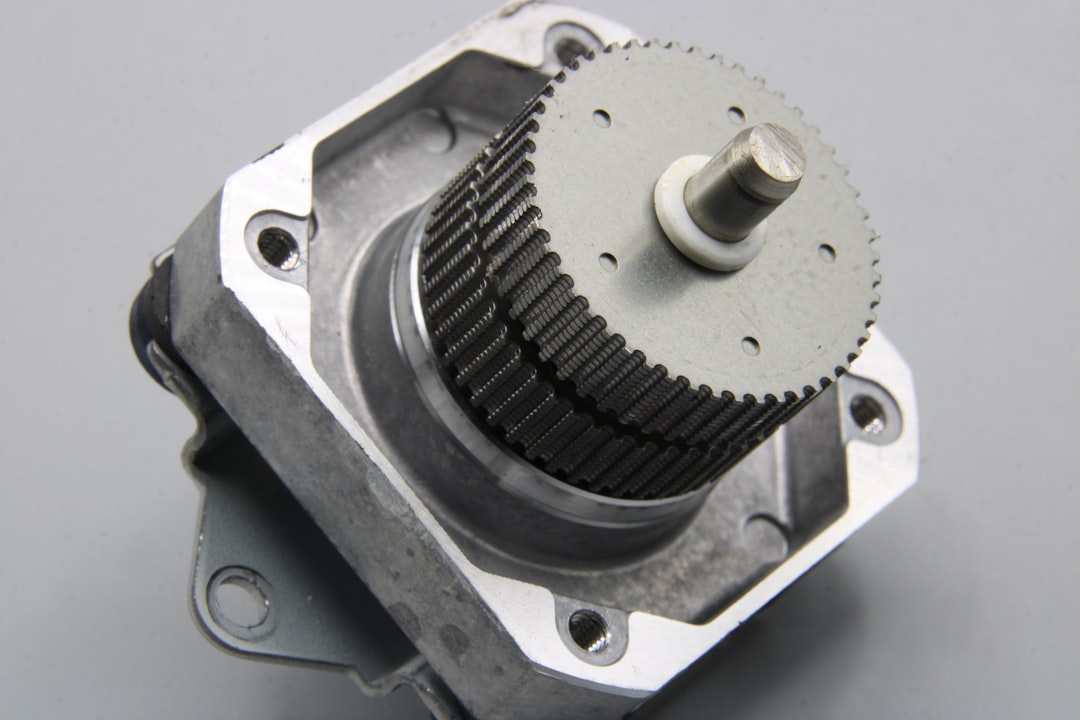
The Heart of Your AC's Airflow
AC fan motor repair is key to keeping your air conditioner running smoothly during Arizona's scorching summers. When an AC fan motor fails, your cooling system can't circulate air, leaving you in the heat.
Quick AC Fan Motor Repair Guide:
- Listen for warning signs - humming, grinding, or no sound
- Check the basics - tripped breakers, loose connections, debris
- Test the capacitor - a common culprit
- Replace worn parts - motors last 10-15 years
- Call professionals - electrical work requires expertise
Your AC has two critical fan motors. The condenser fan motor in your outdoor unit expels heat, while the blower motor inside pushes cool air through your ducts. Both are essential for the heat exchange process. When one fails, your system can't cool effectively.
The good news is that most fan motor problems have clear warning signs. Catching them early can save you from a complete system breakdown during peak summer heat.
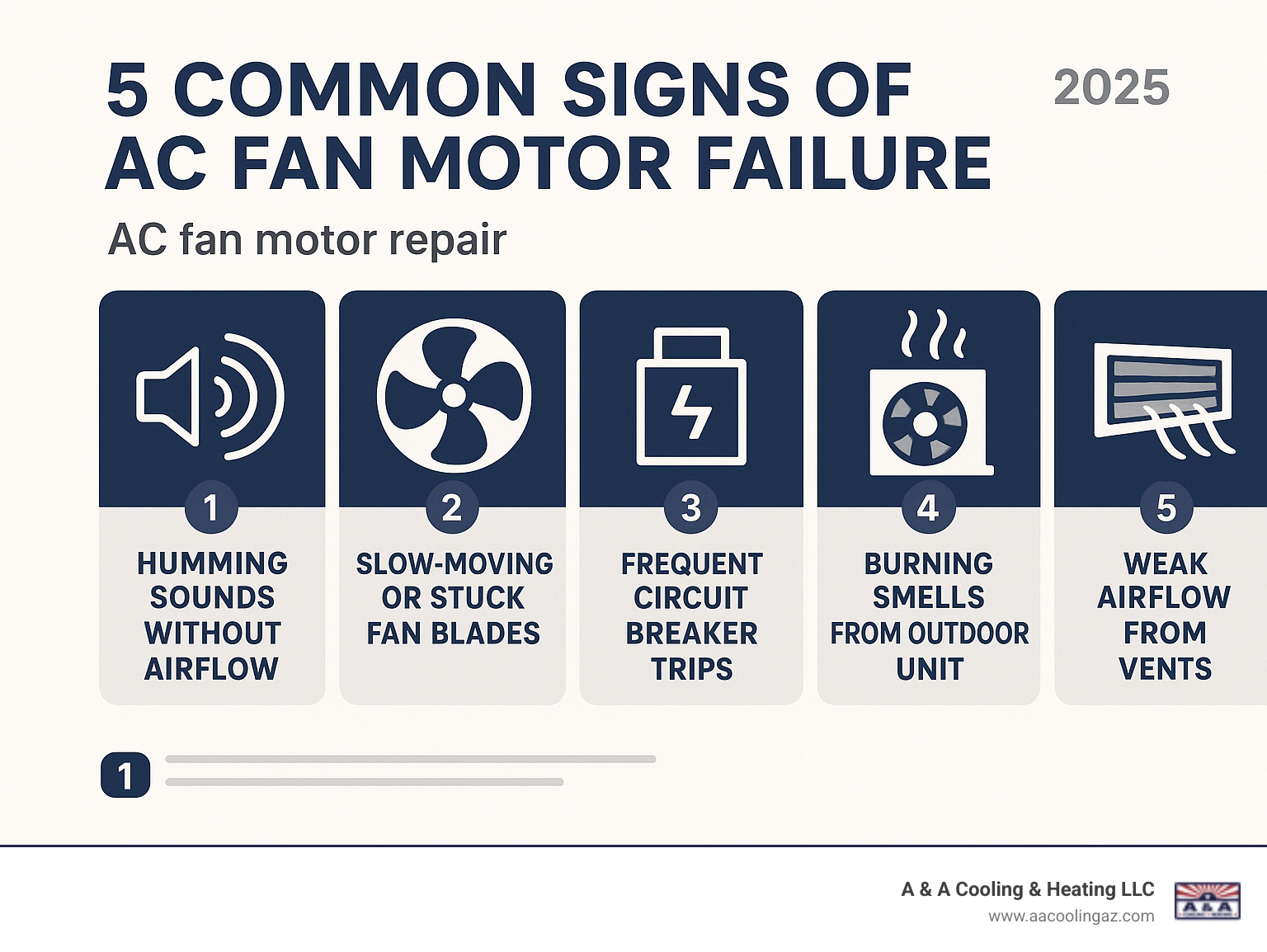
Is Your AC Fan Motor Failing? Diagnosis and Causes
When your AC acts up in Apache Junction's heat, an AC fan motor repair issue often gives you warning signs before a complete shutdown.

A humming noise without fan movement is a classic sign. The motor gets power but can't start, often due to a bad capacitor.
Slow-moving blades indicate a struggling motor. This leads to poor cooling, higher energy bills, and strains the entire system.
If the fan won't start at all, you might hear the compressor kick on, but no air moves. The heat exchange process stops completely.
Overheating is a serious sign. A burning smell or the system shutting down means the motor is running too hot, which is dangerous and can cause permanent damage.
A frequently tripped circuit breaker suggests the struggling motor is drawing too much power. If you're constantly resetting it, it's time to investigate.
For a complete picture of what might be wrong, check our guide on Signs You Need AC Repair.
Common Culprits Behind a Failed Motor
Several usual suspects are behind most fan motor failures.
Faulty capacitors are the most common issue. These parts give the motor the boost it needs to start and run. When they fail, the motor may hum but won't spin. Arizona's heat is especially hard on them.
Worn motor bearings cause friction, leading to grinding or squealing noises before the motor seizes. Lack of lubrication or debris can shorten their 10-15 year lifespan.
Electrical issues like loose connections, corrosion, or power surges can damage the motor's internal wiring.
A bad contactor switch is a faulty relay that fails to send power to the motor, even when the thermostat calls for cooling.
Debris obstruction from leaves, dust, or pests can jam the fan blades, forcing the motor to overheat and fail.
Lack of maintenance allows dirt to build up, throws blades off balance, and lets electrical components fail prematurely. Regular maintenance is your best defense.
You can learn more in our guide on Common AC Repair Issues.
How to Safely Diagnose the Problem
Safety comes first. Always shut off power at your main circuit breaker before touching your AC unit. This step is absolutely non-negotiable.
Once the power is off, here's how to check things out:
- Turn off power at the breaker and double-check that it's off.
- Visual inspection: Remove the top grille and look for debris, damaged blades, or burnt wires. Check if the capacitor is bulging, leaking, or rusty.
- Check for free fan blade movement: Gently spin the blades by hand. They should move freely. Stiffness indicates seized bearings; wobbling means they're worn out.
- Test capacitor with multimeter: If you have a multimeter that measures capacitance, safely discharge the capacitor and test it. A reading significantly lower than specified indicates failure.
- Check for loose wiring: Gently inspect all connections to the motor and capacitor for frayed, burnt, or loose wires.
While some homeowners can handle these checks, electrical work requires expertise. If you're uncomfortable, our article on AC Repair: When to Call a Professional explains when to bring in experts.
Your Step-by-Step Guide to AC Fan Motor Repair and Replacement
While a DIY AC fan motor repair can be satisfying, safety must be your top priority. Your AC unit contains high-voltage electricity that can cause serious injury. Always shut off power at the circuit breaker before starting any work.
The electrical hazards are significant. Replacing a capacitor might be manageable for those with electrical experience, but a full motor replacement is complex. One wrong move can damage other expensive components. Consider if this is a DIY vs. professional job for your skill level.
Step 1: Preparation and Removing the Old Motor
If you've weighed the risks and are ready to proceed, here's how the process unfolds.
- Shut off power at breaker and disconnect: Turn off the circuit breaker for your outdoor unit. Use the disconnect switch near the unit as well. Verify with a voltage tester.
- Remove top grille: Unbolt the protective grille. They can be heavy with sharp edges, so handle with care.
- Disconnect wiring (take photos): Before touching any wires, take multiple clear photos from different angles. This step is crucial for reassembly.
- Unbolt the motor: Remove the bolts holding the motor to its mounting bracket. The fan blade is usually attached with a set screw.
- Lift motor and fan blade assembly out: Gently lift the assembly out, being careful not to bend the sharp fan blades.
Step 2: Installing the New Motor
Now, let's bring your AC back to life.
- Transfer fan blade to new motor: If needed, move the fan blade to the new motor. Clean the shaft and hub, position the blade at the same height as the old one, and tighten the set screw.
- Mount new motor: Lower the assembly into position, line it up with the mounting bracket, and secure it with the bolts.
- Reconnect wiring according to photos: This is where your photos are essential. Match every wire connection exactly as it was before.
- Secure top grille: Reattach the top grille and tighten all bolts.
- Restore power and test: Flip the disconnect switch and circuit breaker back on. Set your thermostat to cool and check that the fan runs smoothly.
Choosing the Right Part for Your AC Fan Motor Repair
Getting the right replacement motor is critical. The motor specifications must match the old one and are usually found on its label.
Check the Horsepower (HP), RPM (spin speed), and Voltage (usually 208/230V). The frame size and shaft dimensions must also match for proper mounting and fan blade fit. Note the rotation direction (clockwise or counter-clockwise).
Always perform a compatibility check with your AC unit's model number. Stick with reputable brands for reliability. Choosing the wrong motor can lead to poor performance, high energy bills, or system damage.
Repair or Replace? Making the Right Choice
When you need AC fan motor repair, you face a common homeowner dilemma: repair the existing motor or replace it entirely? The right choice depends on a few key factors.
| Feature | Repairing an AC Fan Motor | Replacing an AC Fan Motor |
|---|---|---|
| Age of Motor | Suitable for newer motors (under 5-7 years old) | Recommended for older motors (over 7-10 years old) |
| Extent of Damage | Best for minor issues (e.g., faulty capacitor, simple wiring fix) | Necessary for major issues (e.g., burnt windings, seized bearings) |
| Warranty | Repair might be covered if the motor is under warranty. | New motors come with their own warranty for long-term peace of mind. |
| Long-term Reliability | May be a temporary fix if the motor is old or heavily worn. | Provides a fresh start, often extending the AC unit's lifespan. |
The age of your motor is a primary factor. A repair makes sense for younger motors with minor issues like a bad capacitor. However, for motors over a decade old with significant damage like seized bearings or burnt windings, replacement is the wiser long-term solution. Also, consider warranty coverage. An existing warranty might cover repair costs, while a new motor comes with a fresh warranty. In Apache Junction's heat, we often see homeowners caught in a cycle of repairs, which is why we weigh long-term reliability heavily.
The Power of Prevention: Maintaining Your Fan Motor
The best AC fan motor repair is the one you never have to make. Regular maintenance is your best defense against breakdowns.
- Schedule Regular Tune-Ups: Professional maintenance keeps everything running smoothly and catches small problems early. A well-maintained motor can easily last 10-15 years.
- Clean Your Outdoor Unit: Gently hose down your condenser unit every few months (with the power off) to remove dirt and debris. Clear away any obstructions to ensure proper airflow.
- Lubricate Bearings: Older motors may have lubrication ports that require a few drops of motor oil to reduce friction. Most newer motors are sealed and don't need this.
- Change Your Air Filter: A clogged filter makes your indoor blower motor work overtime and can strain the entire system. Check your filter monthly during cooling season.
- Ensure Proper Clearance: Keep at least two feet of clear space around your outdoor unit for efficient airflow.
For comprehensive maintenance, we're here to help with our AC Repair Services in Mesa, AZ and throughout the East Valley.
DIY AC Fan Motor Repair: A Word of Caution
While we've outlined the steps for AC fan motor repair, we must stress the importance of safety and knowing when to call a professional.
Electrical safety is paramount. AC units use high voltage, and capacitors can hold a dangerous charge even when the power is off. One wrong wire can damage expensive components like your compressor, turning a simple repair into a major system overhaul.
Modern AC systems are complex. Diagnosing the root cause—whether it's the motor, capacitor, contactor, or control board—requires experience and specialized tools.
When should you call a professional? If you are uncomfortable with electricity, lack the proper tools, or are unsure of the diagnosis, it's time to call for help. Professionals provide expertise, the right equipment, and warranties on their work.
Our guide on AC Repair: What to Expect explains our transparent process from start to finish.
Frequently Asked Questions about AC Fan Motor Repair
We've answered many questions about AC fan motor repair over our decades of service in Apache Junction. Here are three of the most common.
What is the difference between the condenser fan motor and the blower motor?
Both motors are essential, but they have different jobs.
Your condenser fan motor is in the outdoor unit. It spins the fan to push heat away from the condenser coils and out of your system. It's your AC's exhaust fan.
The blower motor is inside your home in the air handler or furnace. Its job is to push the cooled air through your ductwork and into your rooms.
If either motor fails, your entire cooling system stops working correctly.
How long does an AC fan motor typically last?
A well-maintained AC fan motor can last 10 to 15 years. However, several factors influence this lifespan:
- Usage: In Arizona, where ACs run for many months, motors experience more wear.
- Climate: Extreme heat puts extra stress on all AC components.
- Maintenance: Regular tune-ups and cleaning are the best way to maximize the motor's lifespan. Neglected motors fail much sooner.
- Quality: High-quality parts and proper installation contribute to a longer life. Power surges can shorten it.
Can I run my AC if the fan motor is broken?
No, absolutely not. Running your AC with a broken fan motor can lead to catastrophic system failure.
If the fan isn't spinning, heat cannot be removed from the outdoor unit. This causes a rapid buildup of heat and pressure, forcing your compressor—the most expensive part of your AC—to overheat.
What starts as a manageable AC fan motor repair can quickly turn into a full system replacement. If you suspect your fan motor is broken, turn off your AC at the thermostat and the circuit breaker immediately and call a professional.
Keep Your Cool with Professional HVAC Service
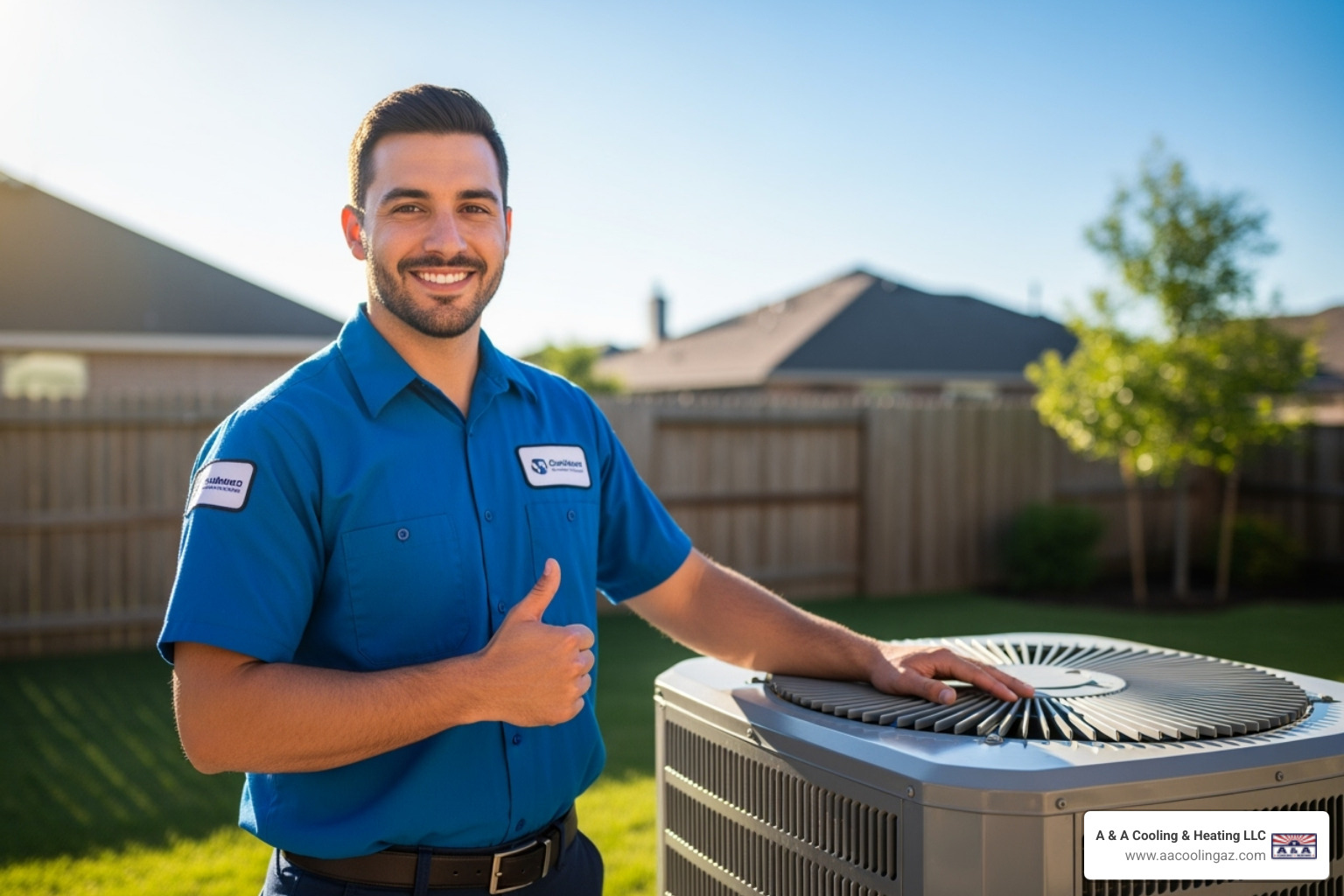
As we've seen, AC fan motor repair is critical for home comfort. The condenser and blower motors are the heartbeat of your cooling system, and their proper function is essential, especially during an Arizona summer.
A professional repair ensures improved energy efficiency, a longer system lifespan, and consistent comfort for your family. While some troubleshooting is possible, the complexity and electrical risks of AC repair make it a job best left to experienced technicians. Proactive maintenance is always your best defense against unexpected breakdowns.
At A & A Cooling & Heating LLC, we've proudly served Apache Junction and the surrounding areas since 1976. Our decades of experience mean we can provide services custom to your specific needs, from diagnosing tricky fan motor issues to complete system installations.
When your fan motor shows signs of trouble, you need a team you can trust. For reliable AC repair in Gilbert, AZ and surrounding areas, contact our experienced team. We're here to help you keep your cool.








